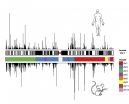(Press-News.org) BOSTON - November 19, 2014 - Each year in the Northern Hemisphere, levels of atmospheric carbon dioxide (CO2) drop in the summer as plants inhale, and then climb again as they exhale and decompose after their growing season. Over the past 50 years, the size of this seasonal swing has increased by as much as half, for reasons that aren't fully understood. Now a team of researchers led by Boston University scientists has shown that agricultural production may generate up to a quarter of the increase in this seasonal carbon cycle, with corn playing a leading role.
"In the Northern Hemisphere, there is a strong seasonal cycle of vegetation," says Mark Friedl, professor in BU's Department of Earth and Environment and senior author of a paper about the research published today in Nature. "Something is changing about this cycle; the ecosystems are becoming more productive, pulling in more atmospheric carbon during the summer and releasing more during the dormant period."
Most of this annual change is attributed to the effects of higher temperatures driven by climate change--including longer growing seasons, quicker uptake of carbon by vegetation, and the "greening" of higher latitudes with more vegetation. "But that's not the whole story," says Josh Gray, BU research assistant professor and lead author on the paper. "We've put humans and croplands into the story."
The scientists gathered global production statistics for four leading crops--corn, wheat, rice and soybeans--that represent about 64 percent of all calories consumed worldwide. They found that production of these crops in the Northern Hemisphere above the tropics has more than doubled since 1961, and translates to about a billion metric tons of carbon captured and released each year.
These croplands are "ecosystems on steroids," says Gray, noting that they occupy about 6 percent of the vegetated land area in the Northern Hemisphere but are responsible for up to a quarter of the total increase in seasonal carbon exchange of atmospheric CO2, and possibly more.
This growth in seasonal variation doesn't have a huge impact on global terrestrial carbon uptake and release, since essentially all carbon in the harvested crops is released each year.
However, understanding the effects of agricultural production, the researchers say, will help to improve models of global climate, particularly in examining how well natural ecosystems will buffer rising levels of CO2 in the future.
Funded primarily though programs supported by the National Aeronautics and Space Administration (NASA) and the National Science Foundation (NSF), the study began in a dinner conversation among the BU scientists, who use remote sensing to study changes on the earth's surface, and atmospheric chemist Eric Kort of the University of Michigan in Ann Arbor.
Kort, a co-author on a 2013 paper by Heather Graven of Imperial College, London and colleagues that demonstrated the overall shift in seasonal CO2 levels but did not look in detail at agricultural production, suggested that contributions from crops could help to explain the magnitude of the shift.
"We thought, somebody should do the math," recalls Gray. Doing a quick analysis with data from the UN's Food and Agriculture Organization, he found that the contribution from crops could be in the right ballpark.
Following up, the BU investigators from the Land Cover & Surface Climate Group collaborated with a team of experts including Kort, Steve Frolking of the University of New Hampshire at Durham, Christopher Kucharik of the University of Wisconsin at Madison, Navin Ramankutty (then at McGill University and now at the University of British Columbia at Vancouver), and Deepak Ray of the University of Minnesota Institute on the Environment. This team used data on Land Cover and Phenology from the NASA Moderate Resolution Imaging Spectrometer (MODIS) Land Cover and Phenology along with many other measurements and statistical products in this study.
The work highlighted the extraordinary increases in crop production in recent decades. "It's a remarkable story of what we've done in agriculture in general," says Friedl. "And in particular corn, which is one crop that's just exploded. Corn alone accounts for two-thirds of the crop contribution to the increased seasonal exchange in carbon, and nearly 90 percent of that is produced in the Midwestern United States and China."
"Over the last 50 years, the area of croplands in the Northern Hemisphere has been relatively stable, but production has intensified enormously," he adds. "The fact that such a small land area can actually affect the composition of the atmosphere is an amazing fingerprint of human activity on the planet."
INFORMATION:
Founded in 1839, Boston University is an internationally recognized institution of higher education and research. With more than 33,000 students, it is the fourth-largest independent university in the United States. BU consists of 16 schools and colleges, along with a number of multi-disciplinary centers and institutes integral to the University's research and teaching mission. In 2012, BU joined the Association of American Universities (AAU), a consortium of 62 leading research universities in the United States and Canada.
ANN ARBOR--In a study that identifies a new, "direct fingerprint" of human activity on Earth, scientists have found that agricultural crops play a big role in seasonal swings of carbon dioxide in the atmosphere.
The new findings from Boston University, the University of Michigan and other institutions reveal a nuance in the carbon cycle that could help scientists understand and predict how Earth's vegetation will react as the globe warms.
Agriculture amplifies carbon dioxide fluctuations that happen every year. Plants suck up CO2 in the spring and summer as they blossom. ...
Physicists at the University of Groningen led by Professor of Functional Nanomaterials Beatriz Noheda have discovered a new manganese compound that is produced by tension in the crystal structure of terbium manganese oxide. The technique they used to create this new material could open the way to new nanoscale circuits. Their findings were published on 20 November 2014 in the journal Nature.
The researchers grew a very thin layer (no more than a few dozen atoms thick) of the terbium manganese oxide crystal on a thicker base layer of strontium titanium oxide. This base ...
In the past years, there have often been cases of fraud in the banking industry, which have led to a considerable loss of image for banks. Are bank employees by nature less honest people? Or does the business culture in the banking sector favor dishonest behavior? These questions formed the basis for a new study by Alain Cohn, Ernst Fehr, and Michel Maréchal from the Department of Economics at the University of Zurich. Their results show that bank employees are in principle not more dishonest than their colleagues in other industries. The findings indicate, however, ...
Looking across evolutionary time and the genomic landscapes of humans and mice, an international group of researchers has found powerful clues to why certain processes and systems in the mouse - such as the immune system, metabolism and stress response - are so different from those in people. Building on years of mouse and gene regulation studies, they have developed a resource that can help scientists better understand how similarities and differences between mice and humans are written in their genomes.
Their findings - reported by the mouse ENCODE Consortium online ...
Cold Spring Harbor, NY - An international team of researchers led by Professor Thomas R. Gingeras of Cold Spring Harbor Laboratory (CSHL) and Roderic Guigo (Centre For Genomic Regulation, Barcelona) has identified some 6600 genes whose level of expression varies within a comparatively restricted range in humans and mice.
This constraint in expression, they found, is unrelated to the degree of similarity of their gene sequences. The 6600 genes represent about one-third of the total set of genes that are typically active in cells across tissues in both species, irrespective ...
This news release is available in Spanish. A group of international researchers has just discovered the keys to explaining why certain processes and systems in mice, like the immune system, metabolism and stress response, are so different to those in humans. The scientists have detailed the functional parts of the mouse genome and have compared them with those in humans. A whole set of data has come out of this - which is now to available to the scientific community - which will be significant for research into mammalian biology as well as the study of human illness ...
Washington, DC--The Endocrine Society today issued a Clinical Practice Guideline (CPG) for the diagnosis and treatment of Paget's disease of the bone, a condition where one or more bones in the body become oversized and weak.
The CPG, entitled "Paget's Disease of Bone: An Endocrine Society Clinical Practice Guideline," will appear in the December 2014 issue of the Journal of Clinical Endocrinology and Metabolism (JCEM), a publication of the Endocrine Society.
As part of its normal processes, the body breaks down old bone tissue and replaces it with new bone. When someone ...
CINCINNATI - Conclusive data show that hydroxyurea therapy offers safe and effective disease management of sickle cell anemia (SCA) and reduces the risk of stroke, prompting early termination by the National Heart Lung and Blood Institute (NHLBI) of a key clinical trial studying the drug's efficacy.
NHLBI officials issued the announcement today, about one year before the study was originally scheduled to end. Going by the title TWiTCH (TCD With Transfusions Changing to Hydroxyurea), the Phase III randomized clinical trial at 25 medical centers in the U.S. and Canada compared ...
CHAMPAIGN, Ill. -- Youth who enter puberty ahead of their peers are at heightened risk of depression, although the disease develops differently in girls than in boys, a new study suggests.
Early maturation triggers an array of psychological, social-behavioral and interpersonal difficulties that predict elevated levels of depression in boys and girls several years later, according to research by led by psychology professor Karen D. Rudolph at the University of Illinois.
Rudolph and her colleagues measured pubertal timing and tracked levels of depression among more than ...
The intense farming practices of the "Green Revolution" are powerful enough to alter Earth's atmosphere at an ever-increasing rate, boosting the seasonal amplitude in atmospheric carbon dioxide to about 15 percent during the last five decades.
That's the key finding of a new atmospheric model that estimates that on average, the amplitude of the seasonal oscillation of carbon dioxide in the atmosphere is increasing at the rate of 0.3 percent every year.
A report on the results of the model, called VEGAS, is published today in the journal Nature.
"What we are seeing ...


